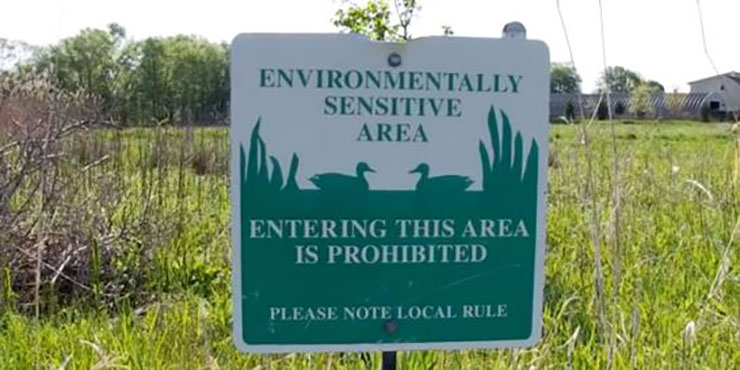As golf courses have become more eco-friendly, there is a good chance you’ll soon encounter, if you haven’t already, an area marked as a “no-play zone.” The term was added to cover a number of marked areas of the course where your ball is not out of bounds, yet you’re not allowed to hit a shot.
In addition to wildlife sanctuaries and other environmentally sensitive areas, no play zones can include areas where there are young and/or fragile features such as trees, flower beds, turf nurseries, etc. It also can be an area where it would be dangerous to play a shot. In Hawaii, for example, hardened lava beds often border fairways and present a real risk of injury for golfers who fall on the jagged rocks. Another area often marked is one of historical significance, such as the ruins of a former building or even an umarked burial site.
When finding your ball in a no-play zone (Rule 2.4), you must take relief. In most cases, these areas are treated as abnormal course conditions, which means you can take relief without penalty. To do that, find the nearest point of complete relief, which is the spot on the course nearest to where your ball lies but not nearer the hole, allowing you to play your next stroke with no interference from the no-play zone. Then drop a ball within one club-length of that point, not nearer the hole.

The other (less fun) way courses or committees can mark a no-play zone is as a penalty area. Just treat it like you plunked one in a pond and proceed under any of the relief options except for being able to play the ball at it lies (and add a stroke to your score).
If you’re wondering how no-play zones are typically marked, the Rules of Golf doesn’t designate a specific color of stakes or lines, but the following is recommended: Penalty area no-play zones should have red or yellow stakes with green tops. Abnormal course condition no-play zones should have white or blue stakes with green tops.
Here’s an important thing to remember: If your ball is outside the no-play zone but your stance or swing would be interfered with by the zone, you cannot play from that spot. Tough break, but if you hit a shot under these conditions, the penalty for playing from the wrong place is loss of hole in match play or two shots in stroke play.
Main image: Environmentally sensitive areas are considered “no play zones” under the Rules of Golf, and have specific rules regarding what to do when your ball enters thess areas. (Photo courtesy of the USGA)









